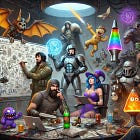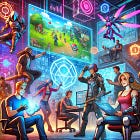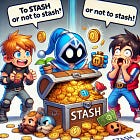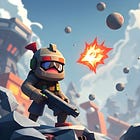37. Expanding Guild and Clan Mechanics with Tribe and Sports Team Dynamics in Game Design
Discussion about Guild and Clan mechanics and how they could be developed further with e.g., Tribe and Sports Team dynamics.
Guilds and clans have long been a staple of multiplayer gaming, fostering a sense of community, cooperation, and long-term engagement.
However, despite their importance, most games in my view only explore around 25% of what is possible with these systems. The remaining 75% represents an untapped frontier — where game designers can leverage tribe and sports team dynamics to create deeper, more emergent, and highly monetizable experiences.
By integrating small and large worldview perception mechanisms, studios could transform these social structures from simple friend groups into powerful strategic, psychological, and even physiological drivers of engagement and monetization.
Small vs. Large Worldview Perceptions in Guild, Clan, and Tribe Systems
In the current state of game design, most guild and clan systems operate within a small worldview perception — focusing on known structures, predefined roles, and direct competition. However, by incorporating a large worldview perception, these systems can evolve to:
Introduce emergent gameplay through e.g., social strategy, trading, and diplomacy.
Expand engagement beyond pure PvP or PvE into dynamic player-driven economies and experiences.
Create deeper identity-building mechanisms that retain players for years.
A small worldview perception fits certain types of games well, particularly in structured competitive formats, whereas a large worldview perception shines in games with emergent and systemic gameplay elements. For example:
In hyper-competitive games (Battle Royales, MOBAs, and FPS titles), a small worldview structure ensures focused teamplay, rapid iteration, and tightly balanced competition.
In expansive, long-term games (MMORPGs, 4X strategy, and trading-based games), a large worldview perception allows for theorycrafting, alliances, and dynamic player-led meta shifts.
Expanding Guild and Clan Systems Beyond the Traditional Model
Most games implement guilds and clans as static social hubs — players join, chat, participate in events, and gain occasional rewards. However, by integrating e.g., tribe and sports team dynamics, we can evolve how these systems function:
1. Tribal Expansion: Identity, Culture, and Emergence
Tribes function differently than traditional guilds — they emphasize e.g., shared identity, long-term goals, and evolutionary change.
A properly designed large worldview tribe in a game would (few examples — but lots of more remains to be explored, into which I’m giving inspiration for everyone with this article):
Develop internal subcultures / substructures, allowing different playstyles and sub-factions to coexist within the same guild.
Create emergent narratives, where e.g., player-driven events, politics, and economy shape the game experience.
Encourage player specialization and legacy-building, where e.g., “veterans” mentor and/or help new members / characters; enhancing long-term retention.
Example in MMORPGs
Imagine an MMORPG where guilds evolve dynamically based on their members' activities. Some might become mercenary legions, some trading conglomerates — while others monastic orders of rare-crafters. This specialization leads to unique perks, economy-driven strategies, and PvP power dynamics.
2. Sports Team Dynamics: Performance-Driven Competition
Sports team structures focus on high-performance recruitment, specialized roles, and competitive optimization.
These elements can be leveraged in game design by (again; few examples — but lots of more remains to be explored, into which I’m giving inspiration for everyone with this article):
Implementing ranked intra-guild leagues, where teams within a guild compete for top status.
Creating training and mentoring (or fast-route character upgrade) programs, where high-skill players actively coach new players (/upgrade new characters) in return for in-game benefits (from systemizing these as well as benefitting from shared benefits / rewards).
Introducing "seasonal drafts", where guilds can scout and recruit top talent, creating a dynamic roster system.
Example in Extraction Shooters
In extraction shooters guilds could have specialized roles — some players focus on raiding, while others supply the group with resources. A sports team-like structure could introduce internal tournaments, strategy boards, and player-driven recruitment.
Side Note: Interested to learn more about Tribe and Sports Team dynamics and how they could be used within your studio? Read these articles:
Monetization Opportunities: Intrinsic and Social Group Monetization
Monetization in these expanded systems can be tailored to match both intrinsic player motivation and social group spending dynamics (again; just few examples to widen my readers’ view on this):
Intrinsic Monetization:
Cosmetic identity-building (guild banners, insignias, unique character customization).
Skill-based progression boosts (mentorship, fast-route character upgrading benefits, role specialization perks).
Long-term ownership mechanisms (legacy achievements, customized guild halls).
Social Group Monetization:
Competitive spending (leaderboards, tournament entry fees, ranked-guild prestige rewards).
Shared assets (guild vault upgrades, team-crafted legendary items).
Group participation incentives (event passes that reward teamwork over solo play).
Side Note: Interested to explore these type of monetization mechanisms more? Read these articles:
Engagement Strategies: "My Tribe vs. Your Tribe" and PvP/PvE Dynamics
The power of tribal psychology can enhance both PvP and PvPvE games, reinforcing long-term engagement.
Some key strategies could include:
PvP: My Tribe vs. Your Tribe Rivalries
Persistent territory control mechanics (e.g., faction wars in MMORPGs and Extraction Shooters).
Seasonal guild feuds where past battles dictate future power structures.
Psychological warfare through in-game politics, propaganda, and espionage mechanics.
PvPvE: Asymmetrical Challenges
Guilds facing world-altering PvE bosses that adapt based on team performance.
Player-driven dungeons that grow stronger as guilds contribute to their expansion.
Dynamic world events that pit player-formed factions against evolving AI threats.
Side Note: Interested about politics and different mechanisms in game design? Check my article about this topic here (https://gamesalchemy.substack.com/p/26-unexplored-frontier-in-game-design):
Ethical Considerations: Long-Term Retention Over Exploitative Monetization
While these systems provide strong monetization potential, there is a fine ethical balance between creating engagement vs. fostering exploitative addiction. Extrinsic monetization strategies, such as forced spending loops or burnout-inducing competitive mechanics, should be avoided. Instead, focus should be on intrinsic strategy-driven spending, ensuring longevity by:
Avoiding over-reliance on FOMO mechanics that force engagement through artificial scarcity.
Designing monetization that enhances social belonging and identity rather than short-term compulsion.
Designing monetization that enhances players’ skills and investment in developing them through mastery.
Prioritizing player-driven economy and status-building over forced pay-to-win structures.
Tip: Seeing game you’re making as an investable hobby over anything else.
Expanding Emergent and Systemic Depth in Game Design
Leveraging emergent gameplay mechanics within these expanded guild systems can lead to deeply engaging player experiences.
Action RPGs & Looter Shooters: Player-run guild shops, territory-based loot distribution, rival warlords.
4X Strategy Games: Cross-guild trade federations, shifting alliances, reputation-based diplomacy.
Match-3 & Merge Games: Clan-wide puzzles, cooperative mega-events, leader-driven puzzle solving.
By rethinking traditional clan and guild mechanics, we can unlock the remaining 75% of potential within these systems. Instead of treating social mechanics as simple multiplayer features, game designers can use them as core engagement and monetization drivers, tailored for both small and large worldview perception mechanisms (as fitted for games they’re making).
Side Note: Interested about emergent and systemic mechanisms as well as on how live ops systems could be built over what I’m discussing in this article? Check out these articles here:
Conclusion: The Future of Guilds, Clans, and Social Systems in Games
The next frontier of game design isn't just about bigger worlds or better graphics — it's about designing deeper social structures that evolve with the players. By adopting e.g., tribe and sports team dynamics, game designers can create more engaging, monetizable, and long-lasting multiplayer ecosystems.
Note: Interested of finding more ingredients to build sustainable games like this article points out? Check out these articles:
The key takeaway:
Guilds and clans shouldn't just be about playing together — they should be about belonging, strategy, and emergent experiences.














